Effect of Low-Temperature Sensitization on Hydrogen Embrittlement of 301 Stainless Steel
Abstract
:1. Introduction
2. Experimental Procedures
3. Results
3.1. Microstructural Observation
3.2. Mechanical Properties
3.3. Fractographic Examinations
3.4. TEM Examinations
4. Discussion
5. Conclusions
Acknowledgments
Author Contributions
Conflicts of Interest
References
- Böhner, A.; Niendorf, T.; Amberger, D.; Höppel, H.W.; Göken, M.; Maier, H.J. Martensitic transformation in ultrafine-grained stainless steel AISI 304L under monotonic and cyclic loading. Metals 2012, 2, 56–64. [Google Scholar] [CrossRef]
- Michler, T.; Naumann, J. Microstructural aspects upon hydrogen environment embrittlement of various bcc steels. Int. J. Hydro. Energy 2010, 35, 821–832. [Google Scholar] [CrossRef]
- Michler, T.; Naumann, J.; Hock, M.; Berreth, K.; Balogh, M.P.; Sattler, E. Microstructural properties controlling hydrogen environment embrittlement of cold worked 316 type austenitic stainless steels. Mater. Sci. Eng. A 2015, 628, 252–261. [Google Scholar] [CrossRef]
- Gey, N.; Petit, B.; Humbert, M. Electron backscattered diffraction study of ε/α′ martensitic variants induced by plastic deformation in 304 stainless steel. Metall. Mater. Trans. A 2005, 36, 3291–3299. [Google Scholar] [CrossRef]
- Bak, S.; Abro, M.; Lee, D. Effect of hydrogen and strain-induced martensite on mechanical properties of AISI 304 stainless steel. Metals 2016, 6, 169. [Google Scholar] [CrossRef]
- Pan, C.; Chu, W.Y.; Li, Z.B.; Liang, D.T.; Su, Y.J.; Gao, K.W.; Qiao, L.J. Hydrogen embrittlement induced by atomic hydrogen and hydrogen-induced martensites in type 304L stainless steel. Mater. Sci. Eng. A 2003, 351, 293–298. [Google Scholar] [CrossRef]
- Lai, C.L.; Tsay, L.W.; Chen, C. Effect of microstructure on hydrogen embrittlement of various stainless steels. Mater. Sci. Eng. A 2013, 584, 14–20. [Google Scholar] [CrossRef]
- Mine, Y.; Narazaki, C.; Murakami, K.; Matsuoka, S.; Murakami, Y. Hydrogen transport in solution-treated and pre-strained austenitic stainless steels and its role in hydrogen-enhanced fatigue crack growth. Int. J. Hydro. Energy 2009, 34, 1097–1107. [Google Scholar] [CrossRef]
- Alyousif, O.M.; Nishimura, R. Stress corrosion cracking and hydrogen embrittlement of sensitized austenitic stainless steels in boiling saturated magnesium chloride solutions. Corros. Sci. 2008, 50, 2353–2359. [Google Scholar] [CrossRef]
- Alyousif, O.M.; Nishimura, R. The stress corrosion cracking behavior of austenitic stainless steels in boiling magnesium chloride solutions. Corros. Sci. 2007, 49, 3040–3051. [Google Scholar] [CrossRef]
- Alyousif, O.M.; Nishimura, R. The effect of test temperature on SCC behavior of austenitic stainless steels in boiling saturated magnesium chloride solution. Corros. Sci. 2006, 48, 4283–4293. [Google Scholar] [CrossRef]
- Lai, C.L.; Tsay, L.W.; Kai, W.; Chen, C. Notched tensile tests of cold-rolled 304L stainless steel in 40 wt. % 80 °C MgCl2 solution. Corros. Sci. 2009, 51, 380–386. [Google Scholar] [CrossRef]
- Lai, C.L.; Tsay, L.W.; Kai, W.; Chen, C. The effects of cold rolling and sensitisation on hydrogen embrittlement of AISI 304L welds. Corros. Sci. 2010, 52, 1187–1193. [Google Scholar] [CrossRef]
- Li, W.J.; Young, M.C.; Lai, C.L.; Kai, W.; Tsay, L.W. The effects of rolling and sensitization treatments on the stress corrosion cracking of 304L stainless steel in salt-spray environment. Corros. Sci. 2013, 68, 25–33. [Google Scholar] [CrossRef]
- Raman, R.; Siew, W. Stress corrosion cracking of an austenitic stainless steel in nitrite-containing chloride solutions. Materials 2014, 7, 7799–7808. [Google Scholar] [CrossRef]
- Garcı́a, C.; Martı́n, F.; Tiedra, P.D.; Heredero, J.A.; Aparicio, M.L. Effects of prior cold work and sensitization heat treatment on chloride stress corrosion cracking in type 304 stainless steels. Corros. Sci. 2001, 43, 1519–1539. [Google Scholar] [CrossRef]
- García, C.; Martín, F.; de Tiedra, P.; Alonso, S.; Aparicio, M.L. Stress corrosion cracking behavior of cold-worked and sensitized type 304 stainless steel using the slow strain rate test. Corros. Sci. 2002, 58, 849–857. [Google Scholar] [CrossRef]
- Ghosh, S.; Kain, V. Effect of surface machining and cold working on the ambient temperature chloride stress corrosion cracking susceptibility of AISI 304L stainless steel. Mater. Sci. Eng. A 2010, 527, 679–683. [Google Scholar] [CrossRef]
- Ghosh, S.; Kain, V. Microstructural changes in aisi 304L stainless steel due to surface machining: Effect on its susceptibility to chloride stress corrosion cracking. J. Nucl. Mater. 2010, 403, 62–67. [Google Scholar] [CrossRef]
- Martin, M.; Weber, S.; Izawa, C.; Wagner, S.; Pundt, A.; Theisen, W. Influence of machining-induced martensite on hydrogen-assisted fracture of AISI type 304 austenitic stainless steel. Int. J. Hydro. Energy 2011, 36, 11195–11206. [Google Scholar] [CrossRef]
- Domankova, M.; Marek, P.; Magula, V. Effect of deformation and heat treatment on grain boundary sensitization in austenitic stainless steels. Metal 2006, 23. [Google Scholar]
- Nasreldin, A.M.; Gad, M.M.A.; Hassan, I.T.; Ghoniem, M.M.; El-sayed, A.A. Effect of hydrogen charging on the tensile and constant load properties of an austenitic stainless steel weldment. J. Mater. Sci. Technol. 2001, 17, 444–448. [Google Scholar]
- Parvathavarthini, N.; Dayal, R.K. Influence of chemical composition, prior deformation and prolonged thermal aging on the sensitization characteristics of austenitic stainless steels. J. Nucl. Mater. 2002, 305, 209–219. [Google Scholar] [CrossRef]
- Silva, M.J.G.; Souza, A.A.; Sobral, A.V.C.; de Lima-Neto, P.; Abreu, H.F.G. Microstructural and electrochemical characterization of the low-temperature sensitization of AISI 321 stainless steel tube used in petroleum refining plants. J. Mater. Sci. 2003, 38, 1007–1011. [Google Scholar] [CrossRef]
- Singh, R. Influence of cold rolling on sensitization and intergranular stress corrosion cracking of AISI 304 aged at 500 °C. J. Mater. Process. Technol. 2008, 206, 286–293. [Google Scholar] [CrossRef]
- Prasanthi, T.N.; Sudha, C.; Parameswaran, P.; Punniyamoorthy, R.; Chandramouli, S.; Saroja, S.; Rajan, K.K.; Vijayalakshmi, M. Failure analysis of a 304 steel component aged at 623 K. Eng. Fail. Anal. 2013, 31, 28–39. [Google Scholar] [CrossRef]
- Lv, J.; Luo, H. Temperature dependence of sensitization on tensile pre-strained AISI 304 stainless steels. J. Alloy. Compd. 2014, 588, 509–513. [Google Scholar]
- Kain, V.; Chandra, K.; Adhe, K.N.; De, P.K. Effect of cold work on low-temperature sensitization behaviour of austenitic stainless steels. J. Nucl. Mater. 2004, 334, 115–132. [Google Scholar] [CrossRef]
- Han, G.; He, J.; Fukuyama, S.; Yokogawa, K. Effect of strain-induced martensite on hydrogen environment embrittlement of sensitized austenitic stainless steels at low temperatures. Acta Mater. 1998, 46, 4559–4570. [Google Scholar] [CrossRef]
- Talonen, J.; Hänninen, H. Formation of shear bands and strain-induced martensite during plastic deformation of metastable austenitic stainless steels. Acta Mater. 2007, 55, 6108–6118. [Google Scholar] [CrossRef]
- Talonen, J.; Aspegren, P.; Hänninen, H.J. Comparison of different methods for measuring strain induced α’-martensite content in austenitic steels. Mater. Sci. Technol. 2004, 20, 1506–1512. [Google Scholar]
- Yokobori, A.T.; Nemoto, T.; Satoh, K.; Yamada, T. Numerical analysis on hydrogen diffusion and concentration in solid with emission around the crack tip. Eng. Fract. Mech. 1996, 55, 47–60. [Google Scholar] [CrossRef]
- Hardie, D.; Liu, S.E. The effect of stress concentration on hydrogen embrittlement of a low alloy steel. Corros. Sci. 1996, 38, 721–733. [Google Scholar] [CrossRef]
- Liu, S.E.; Ziyong, Z.; Wei, K. Notch severity effect on hydrogen embrittlement of type 4340 steel. J. Mater. Sci. Technol. 1996, 12, 51–56. [Google Scholar]
- San Marchi, C.; Michler, T.; Nibur, K.A.; Somerday, B.P. On the physical differences between tensile testing of type 304 and 316 austenitic stainless steels with internal hydrogen and in external hydrogen. Int. J. Hydro. Energy 2010, 35, 9736–9745. [Google Scholar] [CrossRef]
- Neuharth, J.J.; Cavalli, M.N. Investigation of high-temperature hydrogen embrittlement of sensitized austenitic stainless steels. Eng. Fail. Anal. 2015, 49, 49–56. [Google Scholar] [CrossRef]
- Yoshioka, Y.; Yokoyama, K.I.; Sakai, J.I. Role of dynamic interactions between hydrogen and strain-induced martensite transformation in hydrogen embrittlement of type 304 stainless steel. ISIJ Int. 2015, 55, 1772–1780. [Google Scholar] [CrossRef]
- Matsuo, T.; Yamabe, J.; Matsuoka, S. Effects of hydrogen on tensile properties and fracture surface morphologies of type 316L stainless steel. Int. J. Hydro. Energy 2014, 39, 3542–3551. [Google Scholar] [CrossRef]
- Lo, K.H.; Lai, J.K.L. Microstructural characterization and change in a.c. magnetic susceptibility of duplex stainless steel during spinodal decomposition. J. Nucl. Mater. 2010, 401, 143–148. [Google Scholar] [CrossRef]
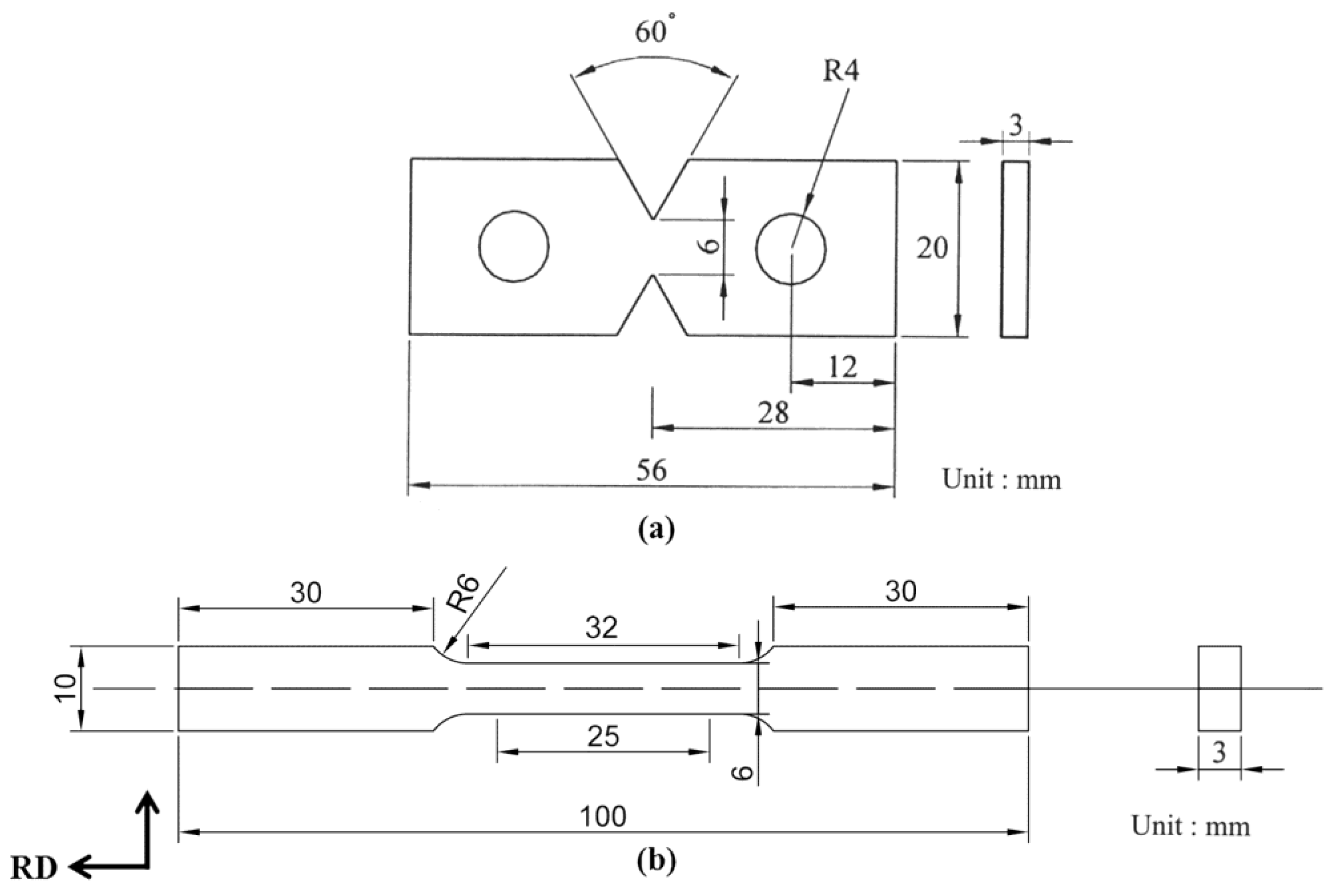


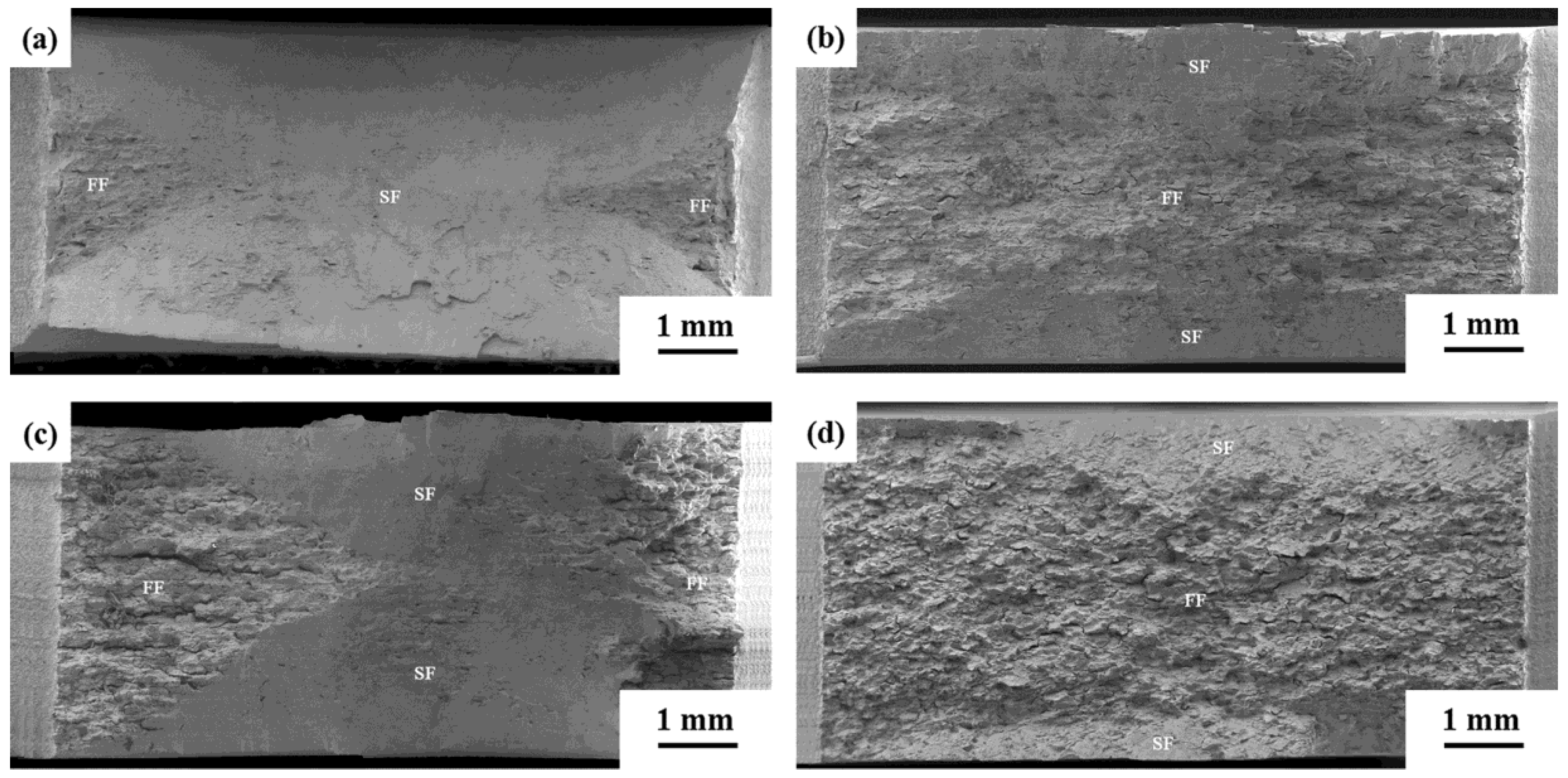

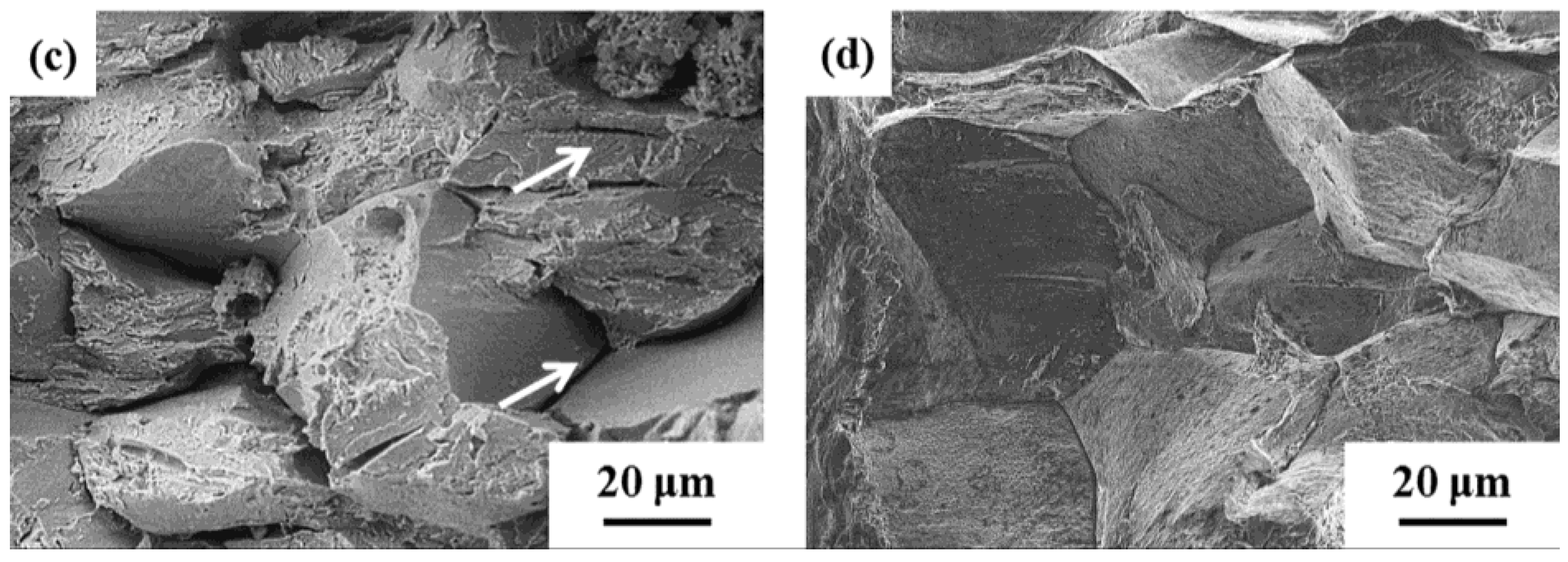

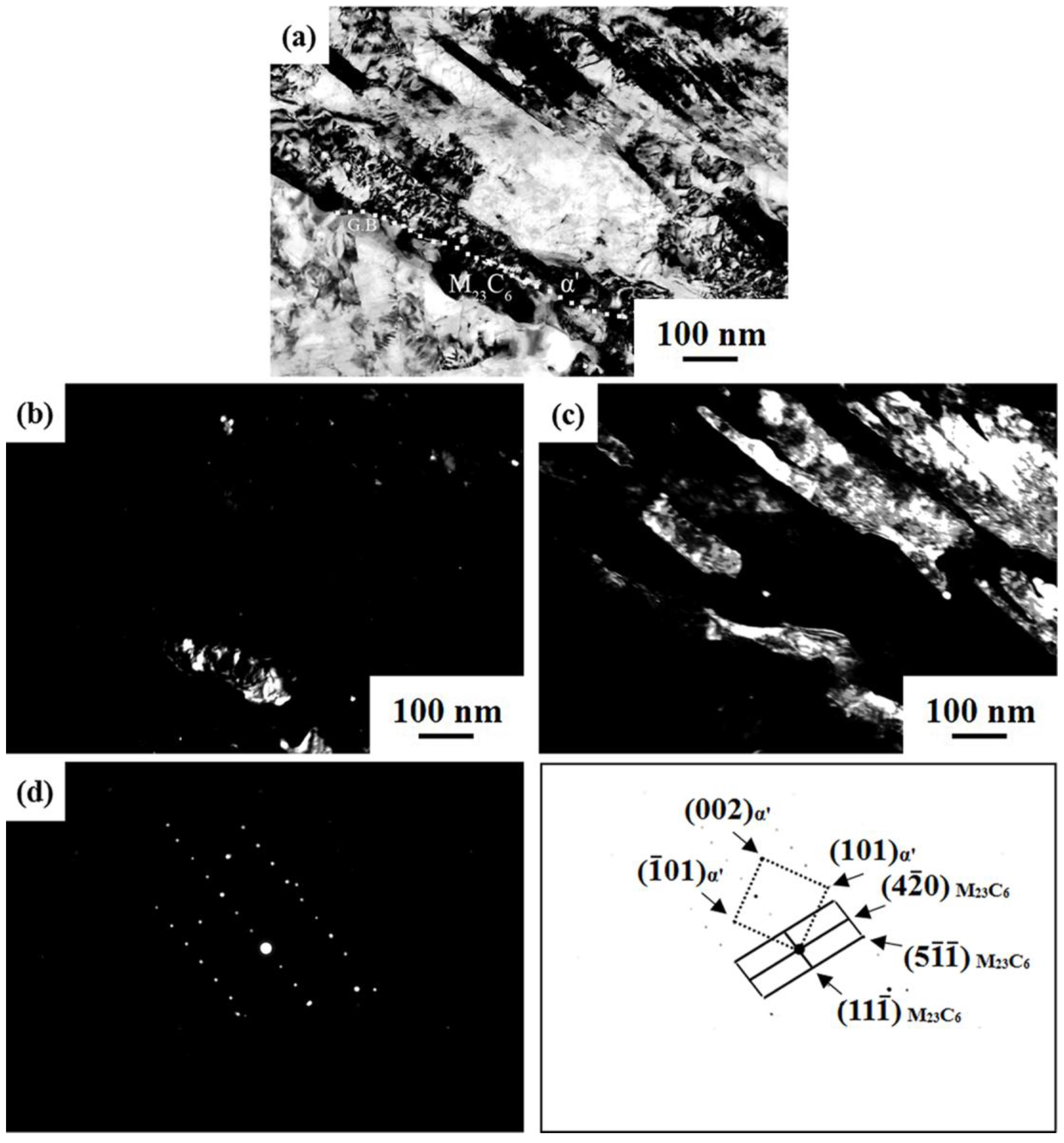
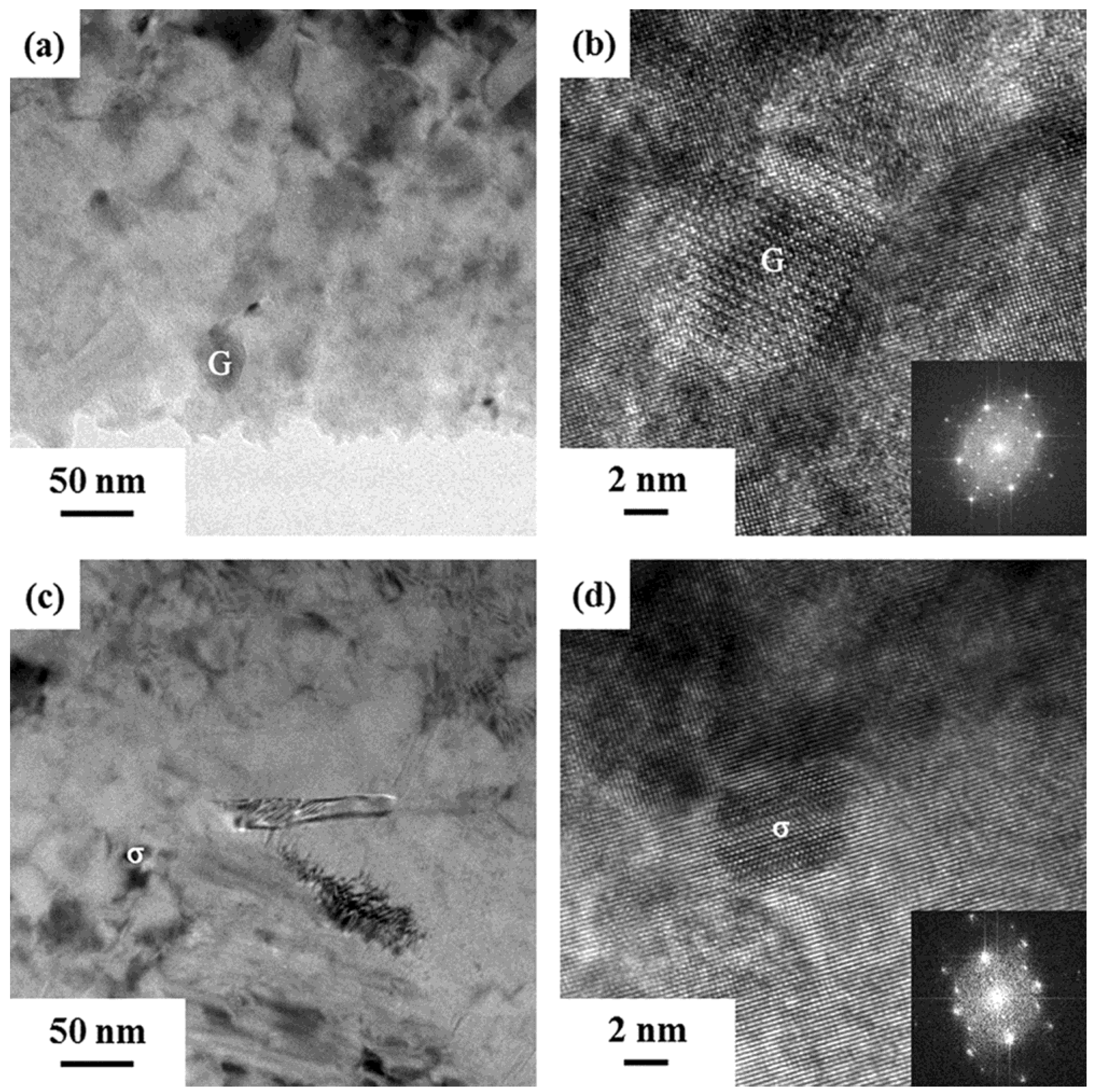
| Specimen | YS a (MPa) | UTS b (MPa) | EL c (%) | Hardness(Hv) | NTS d (MPa) |
|---|---|---|---|---|---|
| CR | 1350 | 1506 | 24 | 455 | 1737 |
| CR-300 e | 1400 | 1544 | 24 | 445 | 1743 |
| CR-450 f | 1200 | 1296 | 24 | 414 | 1584 |
| CR-300H g | - | - | - | - | 1339 |
| CR-450H h | - | - | - | - | 843 |
© 2017 by the authors. Licensee MDPI, Basel, Switzerland. This article is an open access article distributed under the terms and conditions of the Creative Commons Attribution (CC BY) license ( http://creativecommons.org/licenses/by/4.0/).
Share and Cite
Yu, C.; Shiue, R.-K.; Chen, C.; Tsay, L.-W. Effect of Low-Temperature Sensitization on Hydrogen Embrittlement of 301 Stainless Steel. Metals 2017, 7, 58. https://doi.org/10.3390/met7020058
Yu C, Shiue R-K, Chen C, Tsay L-W. Effect of Low-Temperature Sensitization on Hydrogen Embrittlement of 301 Stainless Steel. Metals. 2017; 7(2):58. https://doi.org/10.3390/met7020058
Chicago/Turabian StyleYu, Chieh, Ren-Kae Shiue, Chun Chen, and Leu-Wen Tsay. 2017. "Effect of Low-Temperature Sensitization on Hydrogen Embrittlement of 301 Stainless Steel" Metals 7, no. 2: 58. https://doi.org/10.3390/met7020058
APA StyleYu, C., Shiue, R.-K., Chen, C., & Tsay, L.-W. (2017). Effect of Low-Temperature Sensitization on Hydrogen Embrittlement of 301 Stainless Steel. Metals, 7(2), 58. https://doi.org/10.3390/met7020058







